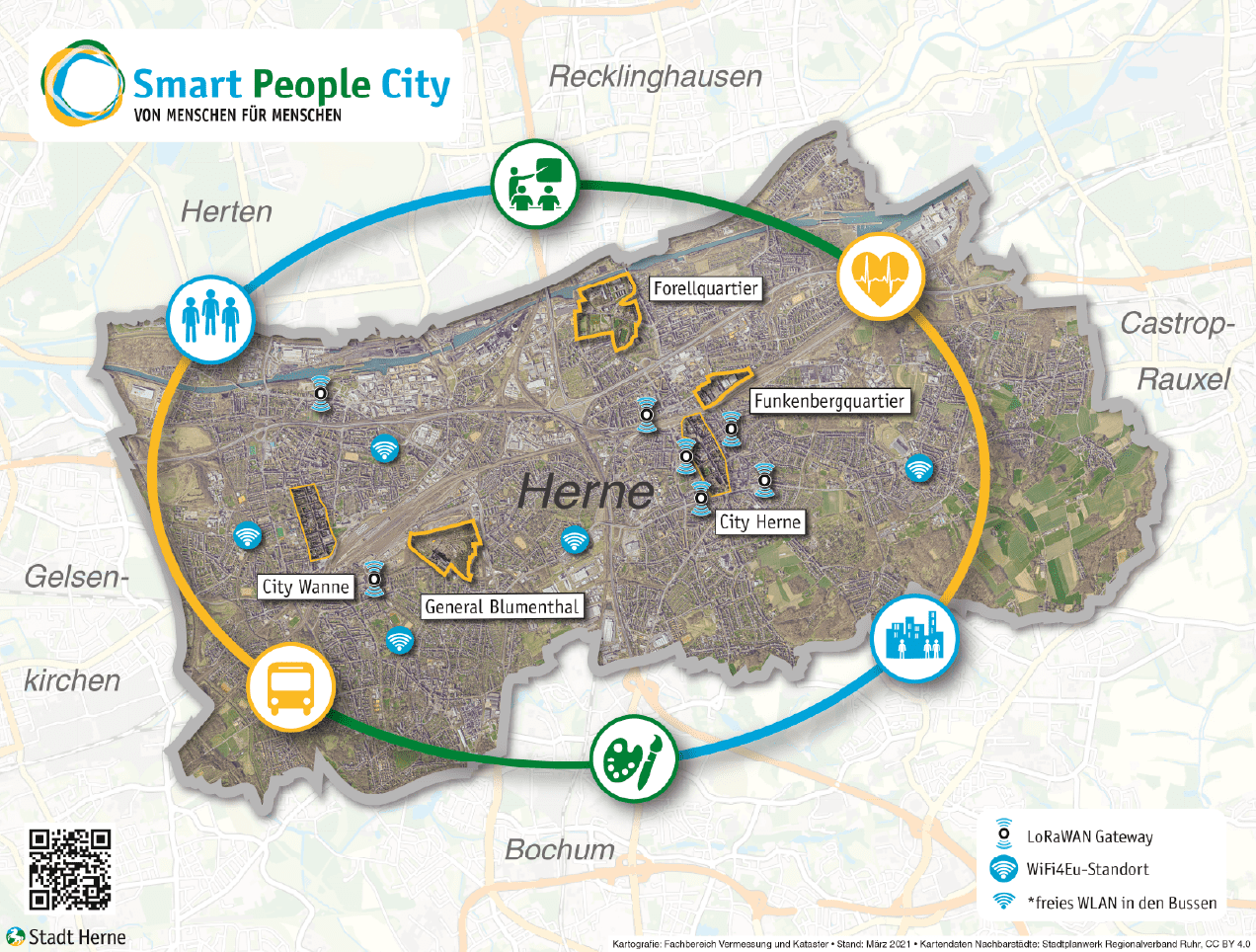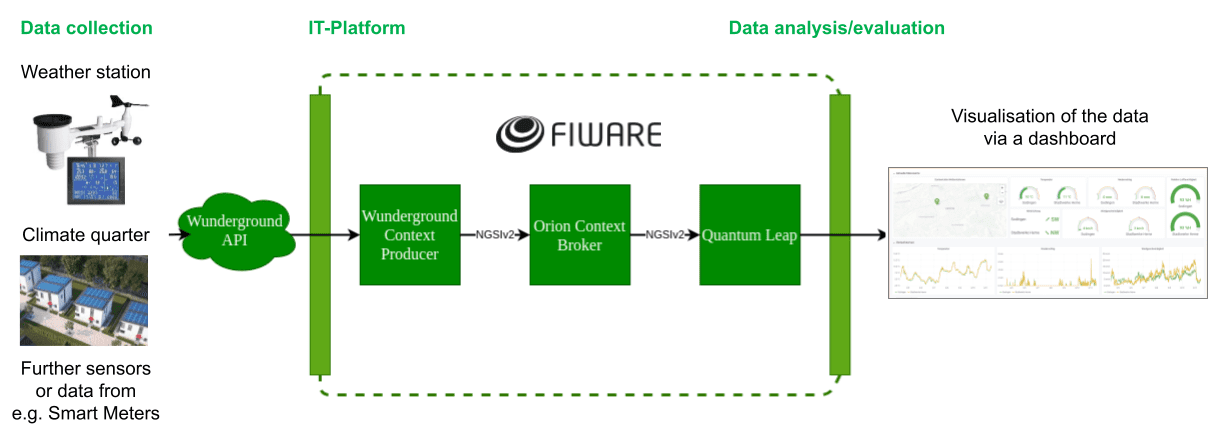Challenge & Context
Climate change is one of the main causes of increasingly extreme weather due to become more intense and frequent. While only 5% of Europeans were exposed to weather related disasters each year during 1981–2010, this number could increase dramatically by the end of this century due to climate change. According to the World Meteorological Organisation, the decade of 2011–2020 was the warmest on record, with the year 2020 being among the 3rd warmest recorded years globally.
The city of Herne makes part of the Ruhr Metropolis (North Rhine-Westphalia), which is the largest urban area in Germany and the third largest in the European Union. It consists of 53 cities and more than 5.1 million residents, and offers, beside others, also huge opportunities for smart city startups to scale with their innovative solutions in the region and Germany as a whole. While the Ruhr Metropolis wants to become Germany’s smartest region, also the city of Herne, with just over 150,000 inhabitants, is not short of ambition when it comes to digital transformation. Under its recently established digitization unit, the city is gearing up for future challenges posed by climate change and extreme weather events. Overseen by the Mayor’s office, the digitization unit is in charge of attracting a worldwide network of premium partners and startups from the digital economy to support the city’s path towards becoming a Smart City, and consequently, part of the Smart Region of “Ruhr”. Specifically, the city of Herne joined forces to see its strategy Herne 2025 being implemented. In order to give the development of the city a clear perspective, the city of Herne has created a vision of the future of Herne that can be summarized in three terms: urban, digital and international.
This mission statement is the basis of urban development that focuses equally on social, economic and ecological aspects supporting resource and climate protection with the use of digital technologies. To implement these strategies, the city requires real-time data of temperature, rainfall, wind speed and for example photovoltaic-production, along with smart grid data. The aim is to be able to produce forecasts for data-driven solutions in order to protect natural resources as consequently the climate, and solve future challenges by increasing the usage of e-Mobility. Furthermore, the utility company of the city has the target to protect shafts from leakage in times of flooding.
Solution
The city has implemented a LoRaWAN-Network featuring the placement of data collecting weather stations. This data is then transmitted by LoRaWAN to the first Smart City’s IT platform based on NGSI-LD technology. Raw data has been visualised and will be used to create digital solutions for utility companies, the mobility company and the city itself in order to have a clear diagnosis of the climate stress points in the city. Furthermore, the shaft sensors communicate when the water level reaches critical points. The utility company can act accordingly with the use of these vital alerts. The next step is to automate electric grid management by using these forecasts and installing smart-metres.
Figure 1 . Ecosystem Map
How it works
The sensors implemented are able to work autonomously for up to 10 years. The station is linked via a LoRaWAN-Network to the database of the city by using NGSI-LD. The raw data is then visualised and published by using Grafana.
In future steps, the city aims to create algorithms to combine photovoltaic production, power consumption and battery stations.
Figure 2 . Platform Architecture
Benefits & Impact
Currently, Herne’s local government, politicians and companies are using the data collected this way, and it’s even planned to be released as open data in the future in order to combine these different sectors of information.
It is believed by the city that this raw data will become increasingly important in the future, especially for urban planning. With each additional use case, the city of Herne expects to create additional benefits for its citizens and companies within the next few years. For example flood protection, heat protection and photovoltaic production are meant to improve usage of regenerative energy, which will be the basis for future projects.
It is projected that potentially 160,000 citizens will be able to access a full overview of their power consumption and therefore have the ability to reduce their ecological footprint by saving precious natural resources and saving money at the same time. These projects are important to fulfil Herne’s strategy to become more sustainable, to protect resources and counteract climate change. How the city embraces the UN Sustainable Development Goals can be looked up in more detail on their landing page Stadt Herne — Herne 2025: Urban — Digital — International.
Additionally, Herne supports to a major extent the strategic objectives of the New Leipzig Charter within its city strategy urban.digital.international. The New Leipzig Charter- The transformative power of cities for the common good was adopted at the Informal Ministerial Meetings organised on 30 November 2020 under German Presidency. It provides a key policy framework document for sustainable urban development in Europe. The city of Herne has an active role in this initiative. One of the latest contributions was given at the conference organized by the Policy Lab for Germany and the Netherlands to discuss “The New Leipzig Charter and its Relevance for Cities”, December 15, 2021, with Pierre Golz participating to the panel discussion about “Digitalization in the wake of the pandemic”.
Added value through FIWARE
Herne has been using FIWARE applications and technology since the beginning of 2019. The city is convinced that NGSI-LD and FIWARE technology were and are the ideal components for these projects due to aspects such as ease of use, availability of open data, and the possibility of combining various sectors of data.
Pierre Golz, the city’s Chief Digital Officer, is in charge of advancing the digitization process of the city. Golz states, “We want to develop innovative solutions, based on FIWARE components and its extended global presence. Connecting different sectors and data sources, today often still in separate ‘silos’, is a chance to lift the potential of digitization. We want to bridge the data based barriers, while using the FIWARE based solutions and the NGSI standard. We will strive to ensure that the city’s digital ecosystem can further grow, as a result of our partnership with FIWARE Foundation”. Golz adds that he plans to “support the idea of promoting a smart region ‘Ruhr’, together with our adjacent cities, based on FIWARE technologies. Furthermore, we would like to share our future proof of concepts for Smart City solutions, based on such technology.”
Next Steps
The next step is to implement a weather station at each square kilometre to collect more qualitative data, after which, the historical data can be used to create trends and forecasts. These forecasts are needed to create solutions and further projects targeting flood management, effluence management, resource-protection projects and photovoltaic stations. Furthermore, citizens life can be enhanced by creating mobility, energy or everyday life services.
These next projects make part of the overall strategy to interact and collaborate with international cities as Herne sees this as a must in times where our lives have long been globally connect ed. Developments in other parts of the world can have a direct impact on citizens’ lives in Herne and on urban development and design. Seen as a competitive factor in a global market also for knowledge and investment, Herne has been promoting active networking with other cities worldwide.
This is very beneficial to the city due to the excellent business, geographical and logistical connections, including port and rail freight transport, with Herne playing an important role in international supply chains. Together with the other cities of the Ruhr Regional Association, Herne will develop the Ruhr Metropolis additionally into a global brand.
Meanwhile, Herne’s Municipal Council has signed the declaration with Living-in.EU to jointly build and boost the European way of Digital Transformation for 300 million Europeans. Digital solutions are broad and include approaches to smart urban mobility, energy efficiency, sustainable housing, digital public services, and civic-led governance. With Living-in.EU, large-scale uptake and upscale of these solutions are crucial to help the European cities and communities meet their climate targets and reduce their environmental footprint, while fostering citizen participation and bringing prosperity to all types of business, including SMEs and start-ups. Earlier, in 2021, FIWARE signed the Living-in-EU’s Joint, Boost and Sustain declaration to become an official supporter.
In early 2022, Herne is following up their strategy definition process — building on the Sustainable Development Goals and the New Leipzig Charta — with the target to align their Herne Strategy 2030 respecting their framework built with ‘Urban.Digital.International’. In the focus: Smart People City.
References
- LoRaWAN und Smart-City-IT-Plattform starten in Herne — inHerne
- Digital Herne Business and its conference “Durchstarten dank Digitalisierung”, June 23, 2021, Kulturzentrum Herne
- Digitales Durchstarten, June 23, 2021, Kulturzentrum Herne: “Durchstarten dank Digitalisierung”. Interview with FIWARE CEO Ulrich Ahle addressing “Platform of Platforms und das GAIA-X-Projekt — Welche Bedeutung haben digitale Plattformen in der Zukunft?
- FIWARE Smart Cities Booklet (ed.02), City of Herne, p. 48–49



